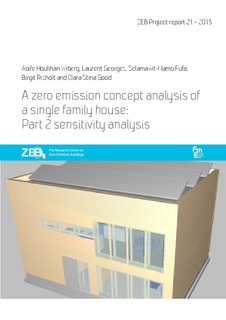A zero emission concept analysis of a single family house: Part 2 sensitivity analysis
Houlihan Wiberg, Aoife Anne Marie; Georges, Laurent; Fufa, Selamawit Mamo; Risholt, Birgit Dagrun; Good, Clara Stina
Research report
Permanent lenke
http://hdl.handle.net/11250/2386611Utgivelsesdato
2015Metadata
Vis full innførselSamlinger
Originalversjon
ZEB Project report. 32 p. SINTEF akademisk forlag, 2015Sammendrag
This report presents the results from a sensitivity analysis regarding the influence of using emission data
from Norwegian EPD’s instead of the generic data from Ecoinvent, using different CO2eq-factors (for
electricity in the operational phase) and electricity load from household appliances on the overall ZEB
residential building performance.
The materials which contribute the most to the embodied greenhouse gas emissions in the original ZEB
concept residential building were selected [1]. The sensitivity analysis is performed by replacing the
generic Ecoinvent data with Norwegian EPD data where available. Even though the embodied
emissions from PV contribute the most emissions, they are not included in this analysis due to the lack
of Norwegian EPD data for PV. Instead, the influence of different PV technologies and different module
orientations on the embodied and avoided emissions is incorporated. Even if the calculation of
embodied emission has uncertainties, the results indicate the annual embodied emissions reduction
from 7.2 kg CO2eq/m2 to 5.8 kg CO2eq/m2 when the generic data is replaced with Norwegian EPD data.
In addition, the sensitivity study investigates the influence of CO2eq-factors for electricity in the
operational phase on the emission balance. Furthermore, the analysis discusses the energy
consumption of electric appliances and how it could be reduced through more efficient products,
especially the hot-fed machines (i.e. washing machines, tumble dryer and dishwasher). The ZEB Centre
has chosen an average CO2eq factor of 132 g CO2eq/KWh for electricity in the operational phase of the
building's lifetime of sixty years. ZEB ambition level ZEB-OM can still not be reached for the residential
concept building. However, to choose higher European CO2eq factors make it possible to achieve this
ambition.
In further work, the calculation of embodied emissions using Norwegian EPD data for other construction
materials should be incorporated. In the second stage of the work, the system boundary should be
extended to include end of life emissions. There is further potential to reduce the embodied emissions
by considering the biogenic carbon stored in wood products and the use of alternative building materials
should also be considered. In addition, further work is thus required to define the potential energy
saving that would result from a shift of standard appliances to high-performance appliances with better
energy efficiency.
